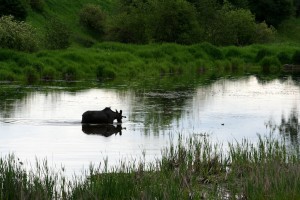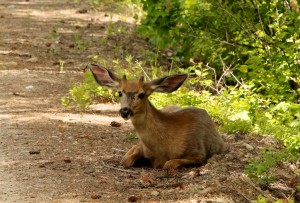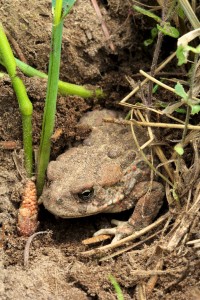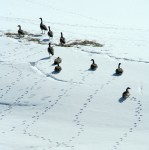On sweltering 90-plus degree days we can retreat to basements or air conditioned buildings but how do animals beat the heat?
Often animals gain relief from the heat in some of the ways we do– taking a dip in the water, finding shade and sweating.
Ponds provide more than a place to forage for moose, they also offer a place to cool down. Water is 50 to 100 times more effective than air at conducting heat which is why people and moose cool down rapidly when in water.
Birds delight in splashing in shallow water or bird baths to cool off. While a bird’s feathers keep it insulated from the cold temperatures of winter, they also insulate the bird from hot temperatures. Taking a bath also helps a bird keep its feathers clean and in prime condition for insulating.
While water itself cools the animal, the effects of being in the water are felt afterwards through evaporation. Amphibians lose heat rapidly through evaporation and we cool down quickly when our sweat evaporates. Not too many animals sweat but the horse is one of them. Dogs also sweat but only on the bottoms of their feet which isn’t enough to cool their entire bodies.
Evaporation is also why animals are seen panting in hot weather. In cold temperatures, the moist air expelled from animals, including people, creates small clouds. In the summer that moisture evaporating helps cool many canines and felines. Of course evaporation only works if the relative humidity is less than 100 percent.
Animals also beat the heat by retreating to the shade. Deer don’t forage in the heat of the afternoon, instead they seek shelter in the timber.
Even cold-blooded species, such as snakes and lizards, need to seek shade so they don’t overheat in the sun. Snakes and lizards retreat to shady spots under rocks, fallen logs or in burrows. Frogs burrow in the mud or seek out wet places while toads and salamanders burrow under leaf litter or sand until ready to come out again.
For some animals, they wait a long time to come out again. Toads, frogs and snails are a few species that enter a state of dormancy, known as aestivation, to avoid heat and dry conditions. Aestivation is the summer version of hibernation. Animals burrow underground and live off body reserves until the rain comes again and the temperatures cool off.
Aestivation isn’t an option for many animals because they have to eat and for some, prepare for winter. So instead rabbits, mice, chipmunks, squirrels, bats, foxes, coyotes, deer, elk and moose lose heat through their ears. Blood flowing to the ears carries heat and the thin skin on the inside of the ears allows the heat to radiate outward and cool the blood. The blood returning to the body is cooler and helps reduce the effect of heat on the rest of the body.
Likewise, any blood vessels near the skin of an animal can be dilated to dissipate heat. In the winter, blood vessels constrict to reduce heat loss at extremities (which is why we can have cold fingers). In the summer, those same blood vessels dilate (known as vasodilation) to allow heat to dissipate.
Just as staying warm in winter is vital to an animal’s survival, so is staying cool in the summer. Animals have developed various strategies to beat the heat, including taking advantage of nature’s air conditioning–water, wind and cool, damp soil.







